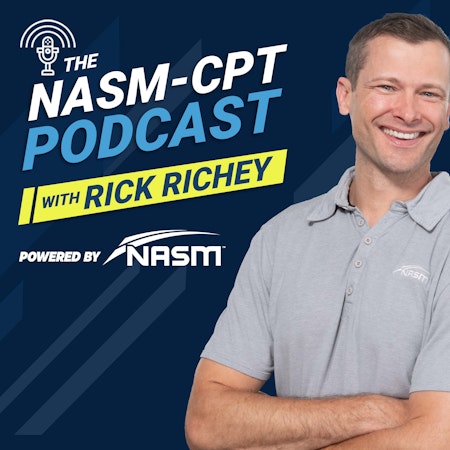
The NASM-CPT Podcast With Rick Richey
Are you studying to become a personal trainer or just started your training career? NASM Master Instructor Rick Richey takes listeners on an informative and engaging journey to help establish a solid foundation in your fitness path.
451
Bringing Fitness Talent to the Masses
33 min
452
A Walk Through: Beyond the First Session
22 min
453
Physical Activity & COVID-19
15 min
454
A Walk Through – My Introductory Sessions
36 min
455
Guidelines for Physical Activity
31 min
456
The Importance of Having a Daily Practice
22 min
457
Drug & Alcohol Recovery – Fitness Concepts
40 min
458
Business Building Basics for CPT’s
30 min
459
Fitness Industry Entrepreneurship & Providing E...
49 min
460
Hip Movement
24 min
461
Understanding Anterior & Posterior Tilt
34 min
462
Understanding Scapular Movement
31 min
463
Fitness and Arthritis
53 min
464
The Business of Coaching and Training
55 min
465
Building Student Engagement Through Gaming
39 min
466
Functional Anatomy – the Rotator Cuff
39 min
467
Balance Training in the OPT Model
41 min
468
Principles of Education in Personal Training
47 min
469
Mental Side of Health and Fitness with NFL Pro-...
54 min
470
A Conversation with Olympian and NASM-CPT Linds...
52 min
471
All About Clinical Exercise
59 min
472
All About One-Rep Max
22 min
473
Introducing the New NASM-CPT 7th Edition
51 min
474
The Power of Positivity in Training
<p>The NASM-CPT Podcast is back with host Rick Richey! Join him as guest Darlene Marshall, CPT and Positive Psychology Coach, stops by to talk about the power of positivity in personal training. Learn techniques on how you can help your clients and yourself by altering your approach.</p><p>Start the new year off right with our FREE course, "The Science Behind Effective Weight Loss." This 5-part mini course covers topics like metabolism, nutrition, exercise, psychology, behavior change, and finally, how you can put it all together. Sign up today! <a href="http://nasm.co/3oimwTK" rel="noreferrer noopener" target="_blank" title="http://nasm.co/3oimwtk">http://nasm.co/3oimwTK</a></p>--- Send in a voice message: https://anchor.fm/nasm-cpt/message
61 min
475
Another Look at Functional Anatomy
<p>Host Rick Richey is back with another functional anatomy review on muscles that were not discussed in the previous series. Functional anatomy helps us better understand produce, reduce, and stabilize forces along with their joint actions. In this episode Rick talks about some of the most discussed muscles in the body: *Lats *Deltoids *And...the pecs! Join us for an enjoyable anatomy review that will help you learn (or provide an excellent review) about these major movers of the upper body and perhaps provide some new insights and perspective on balanced programming based on human movement science.</p><p>Start the new year off right with our FREE course, "The Science Behind Effective Weight Loss." This 5-part mini course covers topics like metabolism, nutrition, exercise, psychology, behavior change, and finally, how you can put it all together. Sign up today! <a href="http://nasm.co/3qjUkRS" rel="noreferrer noopener" target="_blank" title="http://nasm.co/3qjukrs"><strong>http://nasm.co/3qjUkRS</strong></a></p>--- Send in a voice message: https://anchor.fm/nasm-cpt/message
34 min